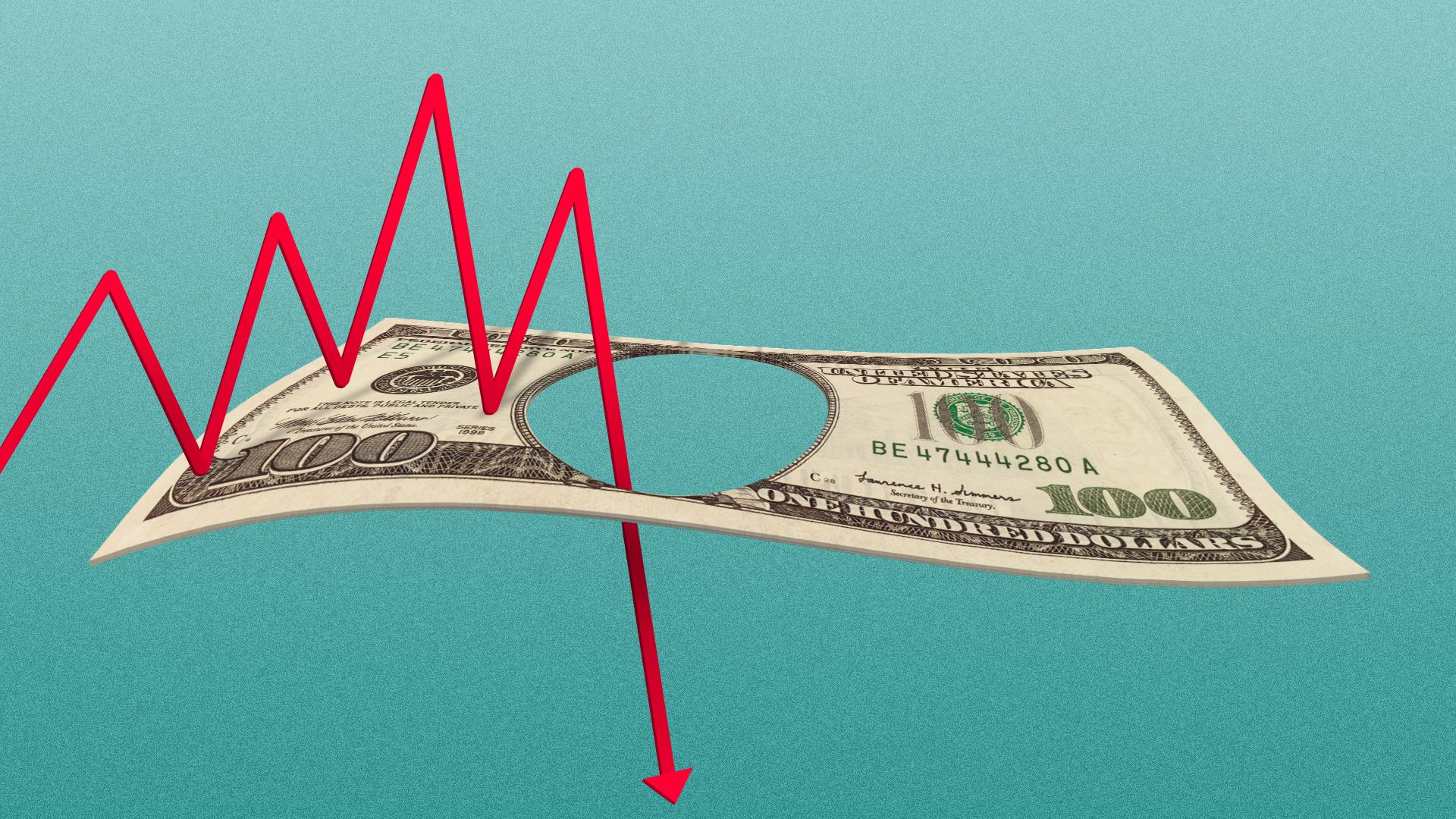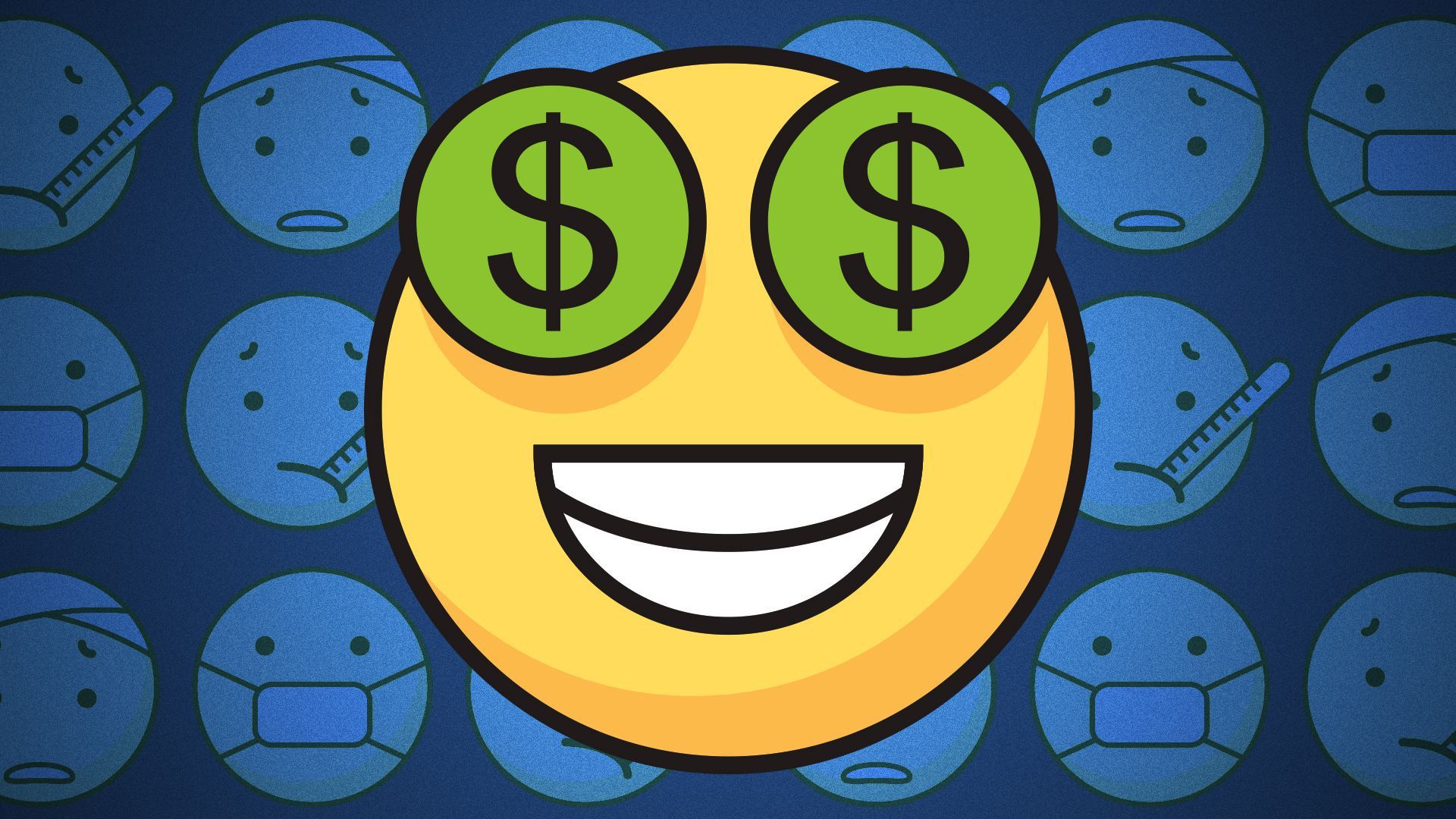| | | | | | | Presented By Northern Trust | | | | Axios Markets | | By Sam Ro ·Aug 30, 2021 | | 🏝 Good morning, Markets readers. I'm on vacation this week and will be back after Labor Day. You're in great hands until then with Axios' business editor Kate Marino. Today's newsletter is 1,288 words, 5 minutes. ⚽️ of the day: 6%, how much Manchester United stock jumped on the day they announced Cristiano Ronaldo would be joining the club. | | | | | | 1 big thing: The harm the Fed wants to avoid |  | | | Illustration: Annelise Capossela/Axios | | | | Fed chair Jerome Powell isn't in a hurry to dial back loose monetary policy because he doesn't want to cause "lasting harm" to the economy. Why it matters: With the economy progressing, everyone wants to know when the Fed will taper its monthly purchases of $120 billion worth of bonds, an emergency policy intended to keep interest rates low and financial markets liquid during the pandemic. Driving the news: Speaking at the Kansas City Fed's Economic Policy Symposium in Jackson Hole on Friday, Powell reiterated his position that the Fed "could" begin to taper its asset purchases by the end of this year. - He stopped short of formally announcing the timing and pace of that taper, in line with what economists were broadly expecting.
What they're saying: Powell spent a good deal of his speech explaining why he thinks the forces driving up inflation in recent months are transitory. At one point, he even warned of the perils of dialing back loose monetary policy after misreading inflation signals, a discussion that multiple Fed-watching economists characterized as dovish. - "If a central bank tightens policy in response to factors that turn out to be temporary, the main policy effects are likely to arrive after the need has passed," Powell said. "The ill-timed policy move unnecessarily slows hiring and other economic activity and pushes inflation lower than desired."
State of play: The personal consumption expenditures price index excluding food and energy (core PCE), is the Fed's preferred measure of inflation and it was up 3.6% year over year in July. This is well above the Fed's average inflation target of 2%. - However, total employment remains about 5.7 million jobs below pre-pandemic levels.
- "Today, with substantial slack remaining in the labor market and the pandemic continuing, such a mistake [of an early policy move] could be particularly harmful," Powell said. "We know that extended periods of unemployment can mean lasting harm to workers and to the productive capacity of the economy."
The big picture: Despite all of this caution, Powell said "it could be appropriate to start reducing the pace of asset purchases this year" as the trajectory of the labor market suggests employment will continue to rise at a robust rate. What to watch: The next U.S. jobs report will be released on Sept. 3. If the number is strong, we could hear the Fed announce the timing of tapering as soon as its next Federal Open Market Committee meeting on Sept. 22. |     | | | | | | 2. Catch up quick | | 95% of U.S. crude oil production in the Gulf of Mexico has been halted as Hurricane Ida hit the coast of Louisiana, closing down the only U.S. terminal able to unload supertankers. Oil prices fell back from their three-week highs. (Reuters) - Insurance losses are likely to surpass $10 billion, and possibly reach as high as $30 billion.
A trucker shortage in the U.K. is threatening to cause chaos in the nation's food supply chain; some businesses want special visas made available to European Union drivers who aren't eligible post-Brexit. (Bloomberg) Baxter is in advanced talks to buy medical equipment maker Hil-Rom in a deal that could value it at around $10 billion. Hil-Rom rebuffed a lower offer from Baxter in recent months. (WSJ) |     | | | | | | 3. A remarkable return of incomes |  | | | Illustration: Eniola Odetunde/Axios | | | | Incomes got a sizable boost in July, Axios' Hope King writes. - Nominal personal income grew 1.1% to $20.67 trillion during the month, accelerating from June's 0.2% monthly rise, according to Friday's government figures.
Why it matters: July's hiring spree and expanded child tax credits drove that growth. This latest form of aid, which began mid-month and runs through the end of the year, comes at a key moment. - Extra unemployment benefits are ending, and because consumers pulled back on spending last month due to new COVID concerns, the stashed-away sums will translate into future economic growth.
Wages and salaries, which exclude government aid payments and other supplements, grew 0.9% month over month to a new high of $10.25 trillion amid job gains. By the numbers: Disposable household incomes, or personal incomes less taxes, rose for the first time since March, by 0.7% to $18.05 trillion. - Consumer spending growth slowed to 0.3% in July, helping savings grow.
- Because incomes outpaced spending, personal saving climbed to $1.72 trillion, which translates to a personal saving rate of 9.6% in July, up from 8.8% in June.
What they're saying: "While the expiry of UI benefits and the absence of another round of checks to families will weigh on income growth in 2022, the ongoing child tax credit and rebounding employment and wages should support household outlays next year," Oxford Economics said in a research note Friday. What to watch: "[W]e believe cooler consumer spending growth is more likely than consumers retrenching and the economy going into reverse," Oxford notes. |     | | | | | | A message from Northern Trust | | Market Currents podcast: Listen now | | |  | | | | Market Currents, a new podcast from The Northern Trust Institute, explores today's most hotly debated investment topics. Join host Katie Nixon as she interviews industry experts to investigate the evidence on both sides by separating facts, myths and theories. | | | | | | 4. Vaccine wave keeps health care as profitable as ever |  | | | Illustration: Shoshana Gordon/Axios | | | | Axios' Bob Herman reports: Hospitals, drug companies, health insurers, medical device manufacturers and other health care suppliers generated record sales and profits during the second quarter, according to an Axios analysis of financial statements. The big picture: Health care spending soared as Americans got vaccinated and resumed seeing their doctors between April and June. State of play: The pandemic has not damaged the finances of most health care companies. - To offset the decline in patient volumes, hospitals, nursing homes and other providers received billions of dollars in federal bailout dollars, most of which were paid out last year.
- Health insurers were never that worried about the coronavirus and collected large piles of cash because they had fewer medical claims to pay.
- Pharmaceutical companies saw some sales dip, but pharmacy prescriptions and infusions have picked back up.
By the numbers: Some pharmaceutical companies and medical device firms continued to hold the highest measures of profitability. - The two companies with the highest profit margins in the quarter: Moderna (64%), which was flush with COVID-19 vaccine sales, and Regeneron (60%), which raked in billions from its COVID-19 antibody treatment.
- Edwards Lifesciences and Intuitive Surgical each posted profit margins above 35% as hospitals resumed surgeries.
- Of course, there were plenty of exceptions to the rule. For instance, telehealth provider Amwell — a company that saw boom times in the early days of the pandemic — saw a negative 63% profit margin.
The bottom line: The fortunes that health care companies continue to amass during the pandemic further insulates them from bigger reforms, just like Big Tech. Go deeper. |     | | |  | | | | If you like this newsletter, your friends may, too! Refer your friends and get free Axios swag when they sign up. | | | | | | | | 5. What I'm watching this week |  | | | Illustration: Eniola Odetunde/Axios | | | | The next U.S. jobs report could be a big market-moving event. Why it matters: As mentioned earlier, the Fed wants to know if the U.S. labor market has made "substantial further progress," the vague threshold that would give the FOMC the confidence to dial back some of its emergency bond purchase program. By the numbers: According to FactSet, economists estimate U.S. employers added 756,500 jobs in August, which would be a slowdown from the 943,000 added in July. - The unemployment rate is estimated to have fallen to 5.2% in August from 5.4% the month prior.
What they're saying: "The softening in employment activity would be consistent with other economic data that have weakened since the surge in COVID case counts due to the Delta variant," Bank of America U.S. economist Joseph Song says. - "Related to that," Wells Fargo economists write, "the FOMC is likely to again consider deteriorating public health conditions as a detriment to 'substantial further progress,' which removes some heft from the August employment report when it comes to determining the timing of potential tapering."
- In other words, assuming job growth did decelerate significantly in August, then the FOMC may wait until after its Sept. 22 meeting to announce the timing of tapering.
What to watch: The August U.S. jobs report will be released at 8:30am ET on Friday. |     | | | | | | A message from Northern Trust | | Trusts and sustainable investing: Building the bridge | | |  | | | | Sustainable investing is on the rise. But one category of investors remains on the sidelines: trustees of personal trusts. Learn how grantors, beneficiaries and trustees can bridge the gap between sustainable preferences and fiduciary duties. | | |  | | It'll help you deliver employee communications more effectively. | | | | | | Axios thanks our partners for supporting our newsletters. If you're interested in advertising, learn more here.
Sponsorship has no influence on editorial content. Axios, 3100 Clarendon Blvd, Suite 1300, Arlington VA 22201 | | | You received this email because you signed up for newsletters from Axios.
Change your preferences or unsubscribe here. | | | Was this email forwarded to you?
Sign up now to get Axios in your inbox. | | | | Follow Axios on social media:    | | | | | |











No comments:
Post a Comment